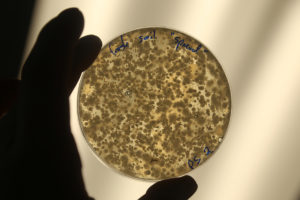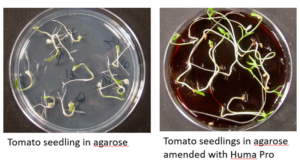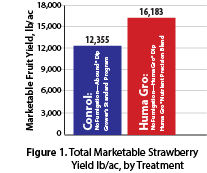Dr. Richard T. Lamar and Dr. Hiarhi Monda of our Humic Research Laboratory, with assistance from analytical chemist Ryan Fountain, have published a methodology video in the biochemistry section of the peer-reviewed online video journal, JoVE.
The video, Quantification of Humic and Fulvic Acids in Humate Ores, DOC, Humified Materials and Humic Substance-Containing Commercial Products, shows the step-by-step laboratory methodology (the New Standard Method) for gravimetric quantification of humic substances (e.g., humic and fulvic acids) on an ash-free basis, in dry and liquid materials from soft coals (i.e., oxidized and non-oxidized lignite and sub-bituminous coal), humate ores and shales, peats, composts and commercial fertilizers and soil amendments.
In the video introduction, Dr. Lamar states, “The New Standard Method for quantification of humic acids provides a more accurate and precise analysis compared to the existing regulatorily accepted methods, and it also provides a standard method for pure hydrophobic fulvic acid quantification. The advantage of this protocol is that it provides a gravimetric analysis of humic and hydrophobic fulvic acid concentrations on an ash-free basis, and the extraction process has been optimized to obtain the highest recoveries of both humic and fulvic acids from samples.
At the video’s conclusion, Dr. Monda states, “Following this procedure, the dry humic and fulvic acids obtained can be used for characterization purposes, such as the carbon-13 and the proton NMR electron resonance, and the ultrahigh resolution mass spectrometry, among other useful techniques. This can be used for characterization of the humus chemistry, as well as being a useful tool to dig deep into the structure-activity relationship with plant fitness and the underlying plant defense mechanisms.
Direct link to video on the JoVE Website: https://www.jove.com/v/61233/quantification-humic-fulvic-acids-humate-ores-doc-humified-materials (A free subscription will be required to view the entire video on the JoVE Website.)
From the JoVE Website: Filmed at the world’s top scientific institutions, JoVE videos bring to life the intricate details of cutting-edge experiments enabling efficient learning and replication of new research methods and technologies. JoVE is a peer-reviewed scientific video journal that is indexed in PubMed and Web of Science.

 Most of the work on agricultural applications of humic substances (HS) has focused on their biostimulant effects on plants. Far less work has been conducted on the effects of HS on soil microbial populations. It’s not surprising to learn, from the few studies that have been published, that HS also stimulate the growth of soil bacteria, even the bacteria that inhabit earthworm digestive tracts. One of the most important discoveries is that many species of soil bacteria are able to grow on humic acid (HA) as their sole carbon source (
Most of the work on agricultural applications of humic substances (HS) has focused on their biostimulant effects on plants. Far less work has been conducted on the effects of HS on soil microbial populations. It’s not surprising to learn, from the few studies that have been published, that HS also stimulate the growth of soil bacteria, even the bacteria that inhabit earthworm digestive tracts. One of the most important discoveries is that many species of soil bacteria are able to grow on humic acid (HA) as their sole carbon source (
 Join us in celebrating the world’s farmers. They have set themselves the almost impossible task of feeding more and more people while using less land and fewer resources.
Join us in celebrating the world’s farmers. They have set themselves the almost impossible task of feeding more and more people while using less land and fewer resources. We lost Jason Garcia this week, his life cut short way too soon.
We lost Jason Garcia this week, his life cut short way too soon. OBJECTIVE
OBJECTIVE OBJECTIVE
OBJECTIVE In its May 2021 issue, Frontiers in Plant Science published a research article by BHN Humic R&D Lab scientists Dr. Hiarhi Monda, Ryan Fountain, and Dr. Richard T. Lamar in collaboration with Dr. Amy McKenna of the National High Magnetic Field Laboratory, Ion Cyclotron Resonance Facility, Tallahassee, Fla.
In its May 2021 issue, Frontiers in Plant Science published a research article by BHN Humic R&D Lab scientists Dr. Hiarhi Monda, Ryan Fountain, and Dr. Richard T. Lamar in collaboration with Dr. Amy McKenna of the National High Magnetic Field Laboratory, Ion Cyclotron Resonance Facility, Tallahassee, Fla.